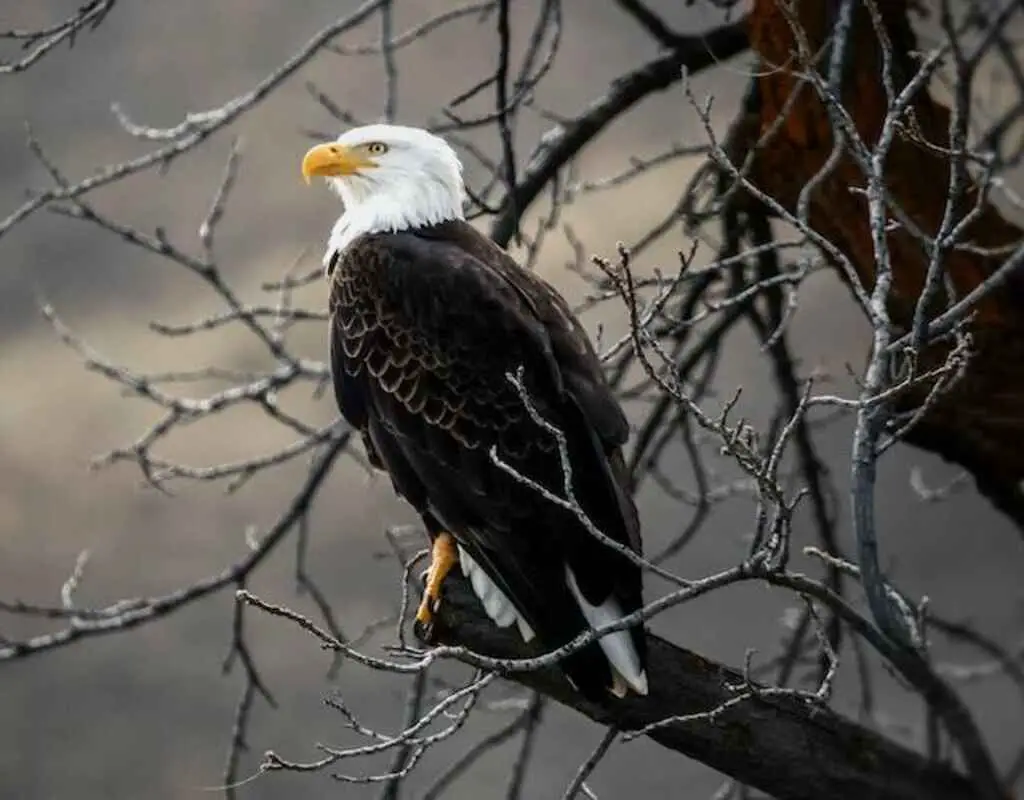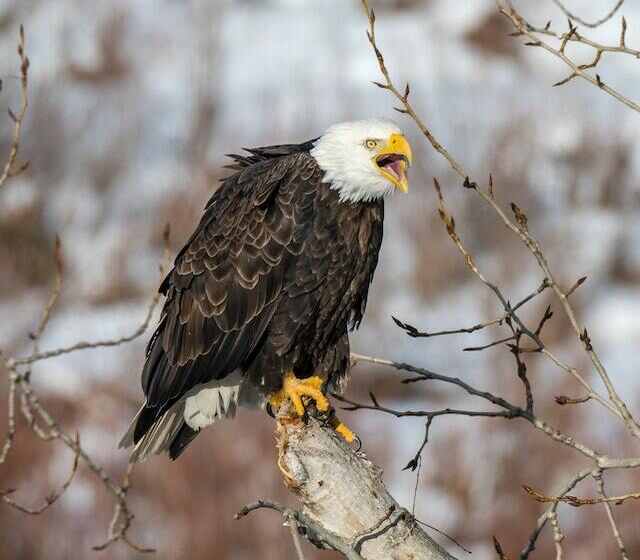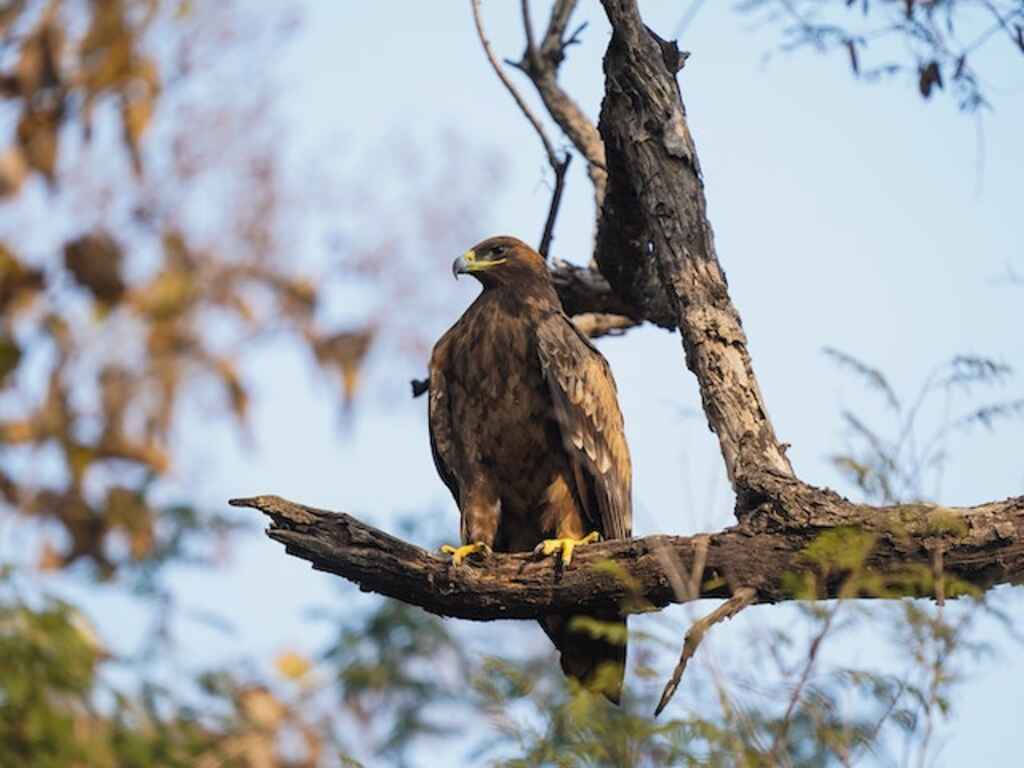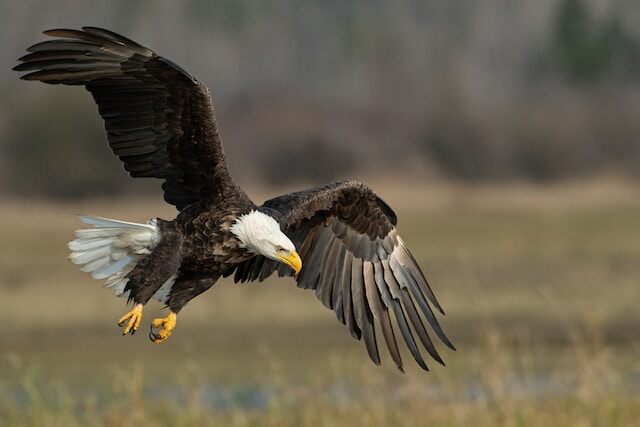Do Eagles Eat Deer? You may be picturing a majestic bald eagle swooping down to snatch a full-grown deer, but hold your antlers!
While the short answer is “No,” these aerial predators have their sights set on smaller prey. Don’t worry, we won’t leave you hanging with just a one-word response.
In this article, we’ll dive into the captivating world of eagle diets and unravel the mysteries behind their hunting preferences.
Join us as we explore the surprising reasons why eagles prefer other meals to venison, and uncover the fascinating intricacies of their predatory habits.
Get ready for a wild ride through the eagle’s menu, guaranteed to make you look at these majestic birds in a whole new light.
So, let’s soar into the details and find out what truly satisfies the eagle’s appetite!
Table of Contents
- 1 Key Takeaways
- 2 Eagles’ Predatory Behavior and Diet
- 3 Do Eagles Eat Deer
- 4 Deer in the Natural Environment
- 5 Rare Instances of Eagle Attacks on Deer
- 6 Size and Strength of Eagles
- 7 Eagles’ Preferential Prey
- 8 Ecological Factors Influencing Eagle-Deer Interactions
- 9 Impact of Human Activities on Eagle-Deer Interactions
- 10 Conservation Efforts for Eagles and Deer
- 11 Misconceptions and Folklore about Eagle-Deer Interactions
- 12 Frequently Asked Questions
- 12.1 Are there any other animals that eagles commonly prey on besides deer?
- 12.2 How do deer defend themselves against eagle attacks?
- 12.3 Do eagles ever scavenge on dead deer carcasses?
- 12.4 Are eagles more likely to attack adult deer or young fawns?
- 12.5 How do human activities such as habitat destruction and pollution affect eagle-deer interactions?
- 13 Conclusion
- 14 Author
Key Takeaways
- Eagles are capable of attacking and consuming deer in certain circumstances, but it is not their primary prey.
- Deer populations are regulated by factors such as predation, food availability, and human activities.
- Ecological competition, population dynamics, and human disturbance can contribute to eagle-deer interactions.
- Conservation efforts for eagles and deer include protecting critical habitats, implementing population monitoring, and raising public awareness.
Eagles’ Predatory Behavior and Diet
Eagles exhibit a predatory behavior and maintain a diet that includes deer as a significant part of their food source. They employ various hunting techniques such as aerial attacks and ambushes to capture their prey.
This predatory behavior has a significant impact on the deer population, as eagles contribute to regulating their numbers and ensuring a healthy balance in the natural environment.
Transitioning into the subsequent section, an understanding of deer in their natural environment is essential.
Do Eagles Eat Deer
No, eagles do not typically eat deer. Eagles primarily target smaller prey such as fish, birds, and small mammals. While they possess impressive hunting skills, deer are generally too large for eagles to capture and consume.
Deer in the Natural Environment
Deer are commonly found in a variety of habitats, including forests, grasslands, and shrublands. They are known for their adaptability to different environments, which allows them to thrive in a wide range of natural settings.
In terms of behavior and characteristics, deer are typically social animals that form herds, although there are also solitary individuals.
They are herbivorous, feeding on a variety of vegetation such as grasses, leaves, and twigs.
Despite their agility and keen senses, deer have several natural predators, including wolves, coyotes, and mountain lions, which play a crucial role in regulating their population size.
Common Habitats for Deer
Woodlands, grasslands, and open fields are some of the common habitats where deer can be found. These habitats provide the freedom for deer to roam and thrive.
In these spaces, deer engage in common behaviors such as foraging for food, seeking shelter, and socializing with other deer.
The deer population dynamics in these habitats are influenced by factors such as food availability, predation, and human activities.
Understanding the behavior and characteristics of deer is crucial for managing their populations effectively.
Behavior and Characteristics of Deer
In their natural habitats, deer exhibit a variety of behaviors and possess distinct characteristics that contribute to their survival and reproductive success.
Mating rituals play a crucial role in deer populations, with males engaging in displays of dominance and courtship behaviors to attract females.
Communication methods among deer include vocalizations, such as grunts and bleats, as well as non-verbal signals like tail flicking and ear movements.
Understanding these characteristics and behaviors is essential in comprehending the strategies employed by predators of deer.
Predators of Deer
Predators of deer, such as wolves and mountain lions, rely on their keen senses and stealthy hunting techniques to secure their next meal.
These predators have a significant impact on deer populations, controlling their numbers and preventing overgrazing.
Some of the hunting techniques employed by these predators include stalking, chasing, and ambushing their prey.
Occasionally, rare instances of eagle attacks on deer have been documented, which will be explored in the subsequent section.
Rare Instances of Eagle Attacks on Deer
The rare instances of eagle attacks on deer are a topic of interest due to the unusual nature of this predator-prey interaction.
Factors that may lead to eagle-deer interactions include scarcity of other prey, high deer populations, and vulnerable deer individuals.
Specific cases of eagle attacks have been documented in various locations, such as Alaska and Canada, where eagles have been observed successfully hunting and preying on deer, typically targeting young or injured individuals.
Factors that may Lead to Eagle-Deer Interactions
Factors such as territorial overlap and changes in prey availability can contribute to the potential for eagle-deer interactions.
- Ecological competition: Both eagles and deer compete for limited resources in their habitats, which may lead to interactions between them.
- Population dynamics: Fluctuations in eagle and deer populations can increase the likelihood of interactions, especially during times of high eagle or deer abundance.
- Human disturbance: Human activities and habitat modification can disrupt the natural balance, potentially bringing eagles and deer into closer contact.
These factors provide insight into the underlying reasons for eagle-deer interactions.
Moving on to specific cases of eagle attacks on deer…
Specific Cases of Eagle Attacks
One notable example of eagle-deer interactions involves instances where eagles successfully capture and consume their prey, resulting in a significant impact on deer populations.
Eagle hunting behavior is influenced by several factors, including prey selection. Eagles are known to target smaller and weaker deer, which may lead to a decline in their numbers over time.
Understanding the dynamics of eagle-deer interactions requires considering the size and strength of eagles, which will be discussed in the following section.
Size and Strength of Eagles
Eagles possess an impressive combination of size and strength, making them formidable predators in the animal kingdom.
1) Bald eagles have a wingspan of up to 7 feet, allowing them to soar high and cover large areas in search of prey.
2) They have sharp, curved beaks and powerful talons capable of gripping and piercing their prey.
3) Eagles are known for their exceptional eyesight, enabling them to spot potential prey from great distances.
4) Their strong territorial behavior ensures a steady supply of food.
Transitioning to the next section, eagles’ preferential prey includes a variety of animals such as fish, small mammals, and birds.
Eagles’ Preferential Prey
The main food source for eagles is fish, which makes up a significant portion of their diet. Eagles are known for their exceptional fishing skills and their ability to catch fish from both freshwater and saltwater environments.
In addition to fish, eagles also prey on birds and rodents, further diversifying their diet.
Fish as the Main Food Source
Fish is the primary food source for eagles, constituting up to 90% of their diet, highlighting their strong dependence on aquatic organisms. This preference for fish is due to the abundance of fish in their habitats.
However, eagles are adaptable predators and can resort to alternative food sources, such as birds and rodents, in times of fish scarcity. This ability to diversify their diet ensures their survival in various environments.
Transitioning to the subsequent section, birds and rodents also play a significant role in the eagle’s diet.
Birds and Rodents in the Eagle Diet
Birds and rodents play a significant role in the diverse diet of eagles, showcasing their ability to adapt and seek alternative food sources when fish are scarce.
Eagles are known to prey on a variety of birds and small mammals, such as rabbits and squirrels. Their dietary preferences are influenced by factors such as prey availability and habitat.
Understanding the interactions between eagles and their prey is crucial in assessing the ecological factors that shape eagle-deer interactions.
Ecological Factors Influencing Eagle-Deer Interactions
Ecological factors such as habitat availability and prey abundance play a crucial role in shaping the interactions between eagles and deer.
Factors influencing habitat availability:
- Landscape composition and structure
- Vegetation cover and quality
- Water availability
Factors influencing prey abundance:
- Population dynamics of deer
- Seasonal variations in food availability
- Predation pressure
Understanding these factors is essential to comprehend the impact of human activities on eagle-deer interactions.
Impact of Human Activities on Eagle-Deer Interactions
This discussion will focus on the impact of human activities on eagle-deer interactions, specifically examining two key points: habitat destruction and fragmentation, and human disturbance and behavior.
Habitat destruction and fragmentation caused by human activities such as urbanization and deforestation can disrupt the natural habitats of both eagles and deer, potentially altering their interactions.
Human disturbance and behavior, including activities such as hunting, recreational activities, and the presence of human infrastructure, can also affect the behavior and interactions between eagles and deer.
Habitat Destruction and Fragmentation
Habitat destruction and fragmentation have significant implications for the interactions between species such as eagles and deer.
As human activities continue to cause habitat loss, both eagle and deer populations are facing a decline.
The destruction and fragmentation of habitat disrupts the natural balance and availability of resources, leading to decreased food sources and suitable nesting sites for eagles, as well as reduced cover and shelter for deer.
This in turn affects their interactions and overall survival. Transitioning into the subsequent section, human disturbance and behavior also play a crucial role in shaping these interactions.
Human Disturbance and Behavior
Human disturbances, including activities such as deforestation and urbanization, as well as human behaviors such as hunting and recreational activities, have been shown to have a significant impact on the interactions between eagles and deer populations.
These disturbances alter the natural habitat and disrupt the normal behaviors of both species, affecting their feeding and breeding patterns.
Understanding the effects of human disturbance on eagle behavior is crucial for implementing effective conservation efforts for both eagles and deer.
Conservation Efforts for Eagles and Deer
Conservation efforts for eagles and deer have been implemented to ensure the preservation of both species in their natural habitats. These efforts include the following strategies:
- Protecting and restoring critical habitats for eagles and deer
- Implementing population monitoring and management programs
- Promoting sustainable hunting practices to maintain healthy deer populations
- Raising public awareness about the importance of coexistence between eagles and deer
These conservation initiatives aim to safeguard the long-term survival of these iconic species.
Moving forward, it is crucial to address misconceptions and folklore about eagle-deer interactions.
Misconceptions and Folklore about Eagle-Deer Interactions
This paragraph will discuss the cultural beliefs and myths, as well as the scientific understanding vs. popular notions, surrounding eagle-deer interactions.
Cultural beliefs and myths often shape the way people perceive and interpret the relationship between eagles and deer.
These beliefs and myths may differ from the scientific understanding of the actual interactions between these two species.
Examining the disparity between cultural beliefs and scientific knowledge can provide insight into how folklore and misconceptions persist in society.
Cultural Beliefs and Myths
Cultural beliefs and myths often present the eagle as a symbol of strength and power, but they do not typically associate it with the act of preying on deer.
In various cultural traditions, the eagle is revered for its majestic flight and hunting prowess, but its diet primarily consists of fish and small mammals.
Despite symbolic representations, scientific understanding of eagle-deer interactions contradicts popular notions.
Scientific Understanding vs. Popular Notions
Scientific research has revealed that the dietary habits of eagles and their interactions with deer differ significantly from popular beliefs and cultural depictions.
Misconceptions vs. Reality: Contrary to popular belief, eagles do not primarily prey on deer. While eagles are capable of hunting small mammals, their diet mainly consists of fish and birds.
Folklore and Science: Cultural beliefs and myths often portray eagles as powerful predators of deer, but scientific understanding challenges these notions.
It is important to differentiate between folklore and scientific facts when discussing the dietary habits of eagles.
Frequently Asked Questions
Are there any other animals that eagles commonly prey on besides deer?
Eagles, apex predators, have a diverse diet. Besides deer, they commonly prey on fish, rodents, and small mammals. Their hunting techniques include soaring, stalking, and ambush. Understanding predator-prey relationships and hunting techniques enhances our knowledge of these majestic birds.
How do deer defend themselves against eagle attacks?
Deer employ various defense mechanisms against eagle attacks, utilizing their agility, speed, and ability to navigate through dense vegetation. Eagles use hunting techniques such as aerial stalking, surprise attacks, and powerful talons to catch their prey.
Do eagles ever scavenge on dead deer carcasses?
Eagles occasionally scavenge on dead deer carcasses, showcasing their scavenging behavior. This behavior can be attributed to food competition, where eagles take advantage of available resources. Freedom-seeking audiences may find this scavenging behavior intriguing.
Are eagles more likely to attack adult deer or young fawns?
Eagle hunting patterns vary, but they are more likely to attack young fawns than adult deer. The impact of eagle predation on the deer population depends on the local ecosystem and the balance of predator-prey relationships.
How do human activities such as habitat destruction and pollution affect eagle-deer interactions?
Human activities such as habitat destruction and pollution significantly impact eagle-deer interactions. Habitat destruction reduces available prey and disrupts ecosystems, while pollution can affect the health and reproductive success of both eagles and deer.
Conclusion
Eagles’ predatory behavior and diet are well-known, but their interactions with deer in the natural environment are rare.
The size and strength of eagles allow them to prey on a variety of animals, but they preferentially target smaller prey.
Ecological factors play a role in eagle-deer interactions, and human activities can impact these interactions.
Conservation efforts aim to protect both eagles and deer.
However, it is important to dispel misconceptions and folklore surrounding eagle-deer interactions.
In conclusion, the captivating dance of the eagle and the deer in the wild weaves a tapestry of nature’s wonders.







